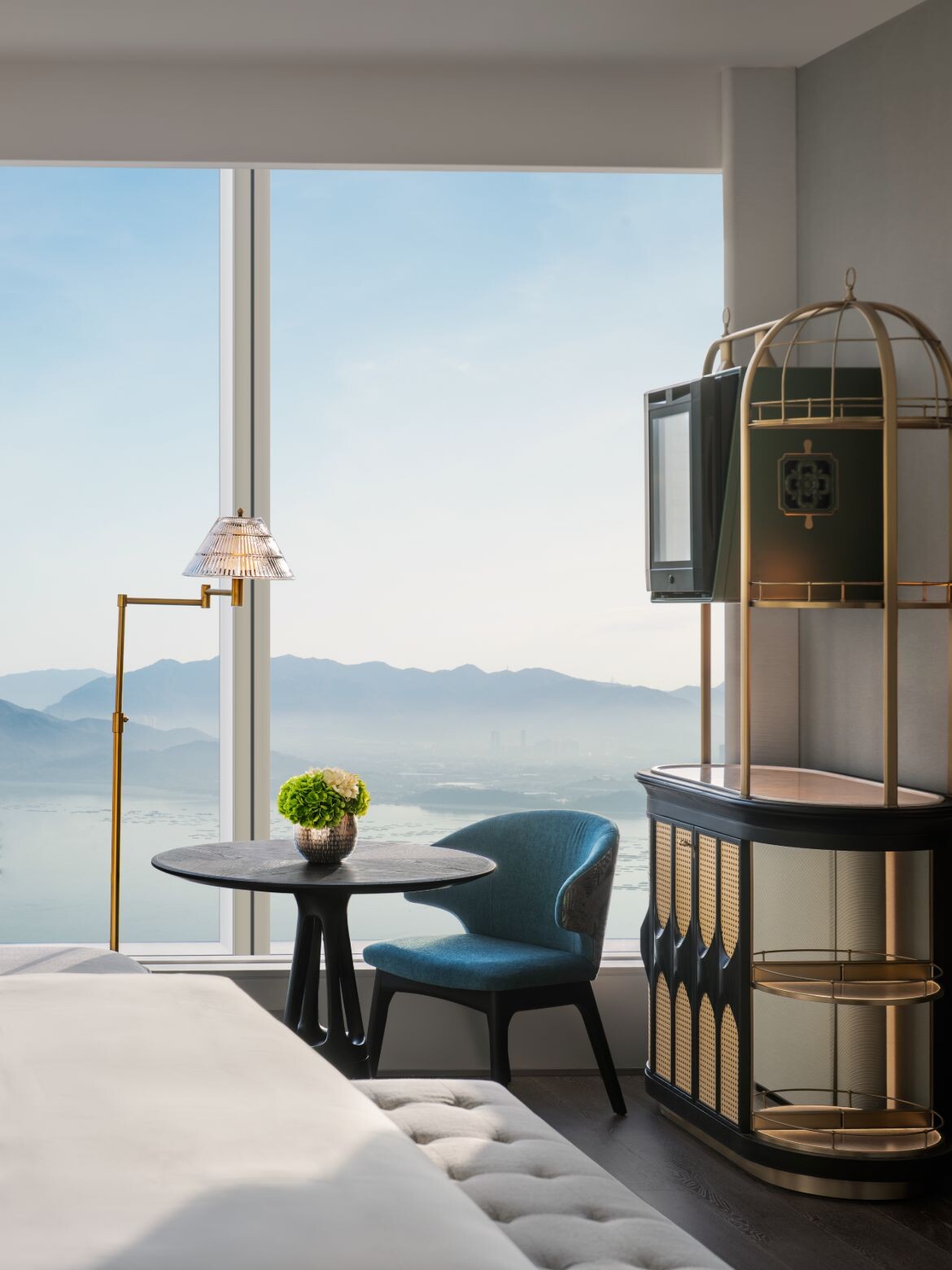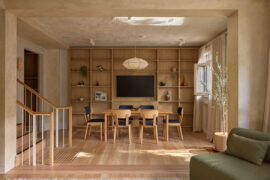Dreamily poetic in his approach to any project, Joe Cheng, director of CCD and UN Cultural Ambassador, has adopted the Fenghuang as the thematic touchstone for Shangri-La Nanshan.

April 23rd, 2025
In many ways, the Shangri-La brand and Cheng were made for each other. Founded in 1971 by Robert Kuok, the name Shangri-La comes from James Hilton’s 1933 novel Lost Horizon, in which a mythical far eastern lamasery of paradisiacal splendour is depicted as the utopian ideal. Cheng has a similar utopian view, citing the poetics of nature and traditional Lingnan cultural elements as appropriate criteria for contemporary luxury.
Geographically, the Lignan region lies south of the Nanling Mountains, comprising the south eastern coast of China (including Hong Kong), and extending to northern Vietnam. With extensive river systems, mountains and regular monsoons, the region is lush with subtropical growth, and a garden culture has evolved. There is an exacting control in this project, adopting a courtyard layout more typically found in Japan that includes pagodas and bridges as part of the garden design. The architectural style of the region favours pale shades of white and green, with open balconies and sculptural forms interwoven with the architecture.

Cheng has drawn these elements together with his design for the Shangri-La Nanshan that is at once splendid and refined. Centring on an impressive inverted pagoda that traverses 12 storeys, the lobby is sinuous and spare. Wanting an open and “densely-eaved pagoda type of traditional Chinese architecture,” the space has been carved to form dynamic parabolas that make “the lofty space appears neither empty nor clumsy,” as Cheng explains. At an impressive 63 metres in height, the space is surprisingly calm with a defined sculptural presence that occupies the void with intent.
Thematically touching on the idea that a phoenix roosts in the parasol tree, the central mythology touches on exclusivity, with these very particular and immortal birds only choosing the best place to rest. For Cheng, however, it is far more poetic, with his take on the theme exploring the idea that “birds return to the nest as the central motif, blending natural poetry with artistic creativity to depict an artistic lifestyle and visual feast in the context of new Lingnan culture.” This is very much in keeping with Cheng’s approach to design, which posits an oriental aesthetic which focuses on taking cultural ideals to create experiential interior spaces.

How this translated to the luxury hotel industry is extraordinary. This is no veneer of Chinese tropes. Rather, each layer is purposefully connected to Lingnan culture with pale cream and white tones forming the sculptural base of the hotel. This is overlaid with velvety greens, slate blues and shades of beige that are almost gold.
Traditional patterns and motifs used in architectural ornamentation are brought in as contemporary iterations, as subtle as a carved paper wall relief or etched carpet. Screens in particular take their aesthetic cues from traditional window details and are found throughout the hotel. The phoenix too is introduced, but not as the multi-hued bundle of flamboyance, but as a subtly elegant and natural bird somewhat like a golden pheasant, surrounded by tropical foliage.
Related: W Maldives is an oceanic idyll

From fabric to gardens, foliage is a constant, with large potted trees as well as green walls, hanging gardens and ebullient floral displays bringing the garden into the hotel experience. The more subtle of these incursions is found in the lobby, where an artwork comprising a shimmering white silhouette of mangrove forms is suspended against one side of the 12-storey atrium. Light plays against these forms which are revealed as nuanced shadows and reflections within the void.
Where the idea of a bird roosting in a magnificent tree comes into focus is in the rooms, which take in the magnificence of Shenzhen Bay coastal belt, Hong Kong, the South China Sea and the steamy OCT Wetlands. At this distance, the layered ideal of Chinese ink paintings with mountains surrounded by mist and waterways is fully realised. This aspect is drawn into the room with a layout that is focused on the view from the bath to the bed. French doors can be closed for privacy, but the ideal is for an open arrangement whereby the green of the bath is picked up by the greenish-blue of the bedhead and on to the mist shrouded mountains and sky.

Cheng’s poetical sensibility and understanding of the aesthetic resonance of culture allows him to craft rarefied spaces that are simultaneously entirely authentic, contemporary and exceedingly lush. The Nanshan version of the signature Shangri-La pool, for example, is sublime. Located on the 77th floor, the spa and wellness club occupies the entire floor, with the pool running lengthwise for optimal view. A large orb is a playful inclusion, which to Cheng’s mind is a poetic encapsulation of the whole: “The brilliant night sky, with its twinkling stars forming a river of light, bathes the moonlit night in a soft glow… The sea forest descends into a tranquil night, embracing stillness, beginning to rejuvenate, and all things grow quietly.”
CCD
ccd.com.hk
Photography
Wang Ting









Next up: W Bali Seminyak revisited after a decade of operation
INDESIGN is on instagram
Follow @indesignlive
A searchable and comprehensive guide for specifying leading products and their suppliers
Keep up to date with the latest and greatest from our industry BFF's!
The new range features slabs with warm, earthy palettes that lend a sense of organic luxury to every space.

Welcomed to the Australian design scene in 2024, Kokuyo is set to redefine collaboration, bringing its unique blend of colour and function to individuals and corporations, designed to be used Any Way!

Merging residential living with the retail experience, the latest project from In Addition breathes new life into shopping for the home.

The Mim x Tim show: Miriam Fanning of Mim Design joins Timothy Alouani-Roby at The Commons in Melbourne to discuss art, design on television, interior design and more.
The internet never sleeps! Here's the stuff you might have missed

The Standard, Singapore by Ministry of Design has been crowned winner of The Social Space at the INDE.Awards 2025. Redefining hospitality with a lush and immersive experience, The Standard celebrates both community and connection.

AHEC’s KEEP exhibition at Cult Sydney sees six Australian architects craft lasting furniture pieces, on view until 4th October.

Annabelle Smith has been named winner of The Graduate at the INDE.Awards 2025, in partnership with Colorbond. Her visionary project reimagines housing in Aotearoa, proposing a modular and culturally responsive model uniting people, architecture and nature.